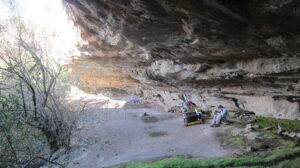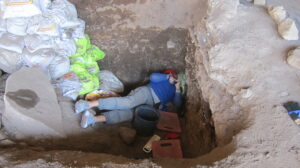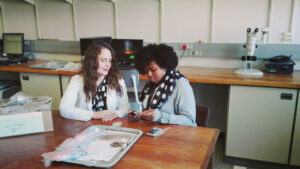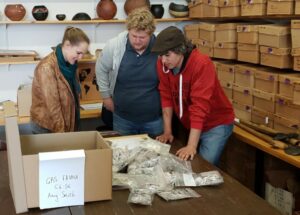Guest Blog: Benjamin Collins

In 2015 Dr. Benjamin Collins was awarded a Post-Ph.D. Research Grant to aid research on “Late MIS 3 Behavioral Diversity: The View from Grassridge Rockshelter, Eastern Cape, South Africa”. Recently Dr. Collins reached out to Wenner-Gren to share an update from the field.
2018 Fieldwork Update from Grassridge Rockshelter, Eastern Cape, South Africa
Dr. Benjamin Collins and Dr. Christopher Ames are leading Wenner-Gren Foundation-funded research at Grassridge Rockshelter that explores the dynamic between hunter-gather behavioral diversity, social network formation, and regional-scale climatic variability during the Late Pleistocene and Holocene in southern Africa. This research forms the core component of the Grassridge Archaeological and Paleoenvironmental Project (GAPP), which focuses on the understudied interior grasslands region of South Africa. Collins and Ames are currently focusing research on Grassridge Rockshelter, a multicomponent site with human occupations dating to the Late Pleistocene (~40,000 years ago and earlier), the early Holocene (~11,600 years ago), and the mid-Holocene (~7,000 years ago). Their ongoing research is collaborative and multidisciplinary – bringing together a variety of perspectives to reconstruct past human technologies and behaviors, and to develop high-resolution paleoenvironmental and geochronological records.

Past technologies and behaviors are explored through stone tool analysis, analysis of symbolic artifacts, such as beads and pendants, and the analysis of the animal remains. Dr. Jayne Wilkins and Ms Ayanda Mdludlu are leading the stone tool analysis, with preliminary results suggesting a diverse range of stone tool manufacturing strategies during the Late Pleistocene and Holocene occupations at Grassridge. These strategies exhibit more differences than similarities in comparison with other contemporaneous sites in southern Africa, and are indicative of greater diversity in technological behaviors during these periods than previously thought.
Shell beads are ubiquitous within the Holocene occupations at Grassridge. Ongoing analysis of these symbolic artifacts, conducted by Dr. Collins and Dr. April Nowell, demonstrates an abundance of ostrich eggshell beads in all stages of manufacture, as well as marine shell beads that indicate a relationship to the coast, which was at least 200 km away from the site. These results reinforce the presence of extensive social networks during the Holocene in southern Africa, and suggest that Grassridge was an important social nexus between coastal, interior, and montane landscapes.

Initial results from the study of the animal remains, led by Dr. Jerome Reynard, Thomas Beard, and Amy Smith, demonstrate a greater diversity of bovids than expected during the Holocene, and suggest changes in hunting strategies and local environments between the early and mid-Holocene occupations. This research also contributes to the development of a high-resolution paleoenvironmental record, with the data from the animal remains being combined with information from stable isotope analyses of recovered animal teeth, pollen and phytoliths extracted from the sediments, and an examination of the site formation processes. Stable isotope research by Dr. Judith Sealy tracks the proportions of C3 and C4 grasses through the early and mid-Holocene and will provide key information on past environmental conditions at Grassridge. Pollen and phytoliths are being studied by Dr. Carlos Cordova and the data indicate substantial differences in the local environments during the different occupations, as well as providing insight on human use of plants within the shelter, especially as firewood. The microbotanical research also contributes to the study of site formation processes, which Dr. Ames combines with stratigraphic and sedimentological analyses to reconstruct the sequence of site formation processes. The data indicate a variable presence of water and flooding in the shelter at the end of the Late Pleistocene, as well as intensive human activity and hearth construction during the mid-Holocene.

GAPP is refining the chronological resolution of the occupational sequence at Grassridge through radiocarbon analysis, Uranium-Thorium analysis, and Optically Stimulated Luminescence. In collaboration with Dr. Emma Loftus, a suite of radiocarbon age estimates have been analysed from Grassridge, which have been fundamental in identifying the early and mid-Holocene occupations. Dr. Robyn Pickering is further contributing to the developing the chronological resolution of the sequence by applying Uranium-Thorium dating techniques to estimate the age of a flowstone that separates the Pleistocene and Holocene deposits, information that will also provide unique insights into the local environment and site formation processes during the Pleistocene-Holocene transition. Dr. Luke Gliganic is leading the Optically Stimulated Luminescence analysis, which will clarify the Late Pleistocene occupational sequence at Grassridge, as these occupations are beyond the limit of radiocarbon dating.
Initial results and ongoing analyses provide valuable insight into the archaeology and paleoenvironments preserved in the rich archive from Grassridge Rockshelter, and are furnishing a detailed, multi-faceted understanding of life in the interior grasslands of southern Africa over the past 40,000 years. These data point to a record of changing local environments and human lifeways over time that, as more analyses are completed, will inform our understanding of human-environment dynamics during periods of rapid and profound climate change. As this new information is compared to, and contextualized within, the broader southern African record, it will shed light on social network formation and human adaptation to climate variability at local, regional, and subcontinental scales from the end of the Late Pleistocene through the mid-Holocene.